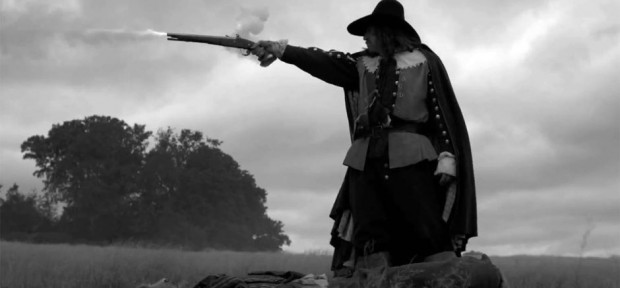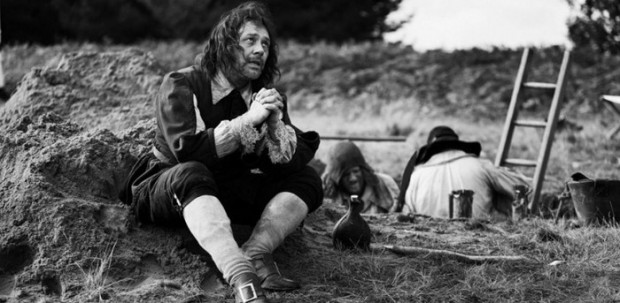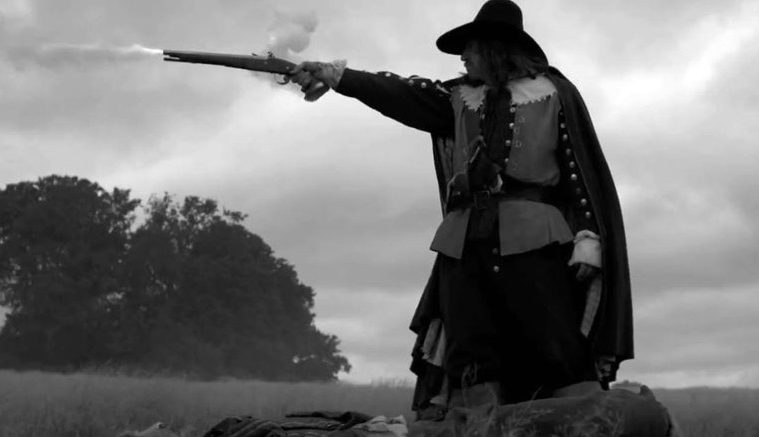
Director Ben Wheatley has made a name for himself by delivering films that defy what one might expect and go down the rabbit hole of whatever tickles his fancy. His latest film, A Field In England, which releases on VOD everywhere and in limited theaters on Friday, is shot entirely in black-and-white and has a loose narrative structure that drops one in the middle of a battle in England. Adjoined to the film is a bombastic and muscular score by James Williams. During Fantastic Fest last year I had the opportunity to sit down with Wheatley to discuss his goals in terms of pacing, why he doesn’t like using temp scores, and bringing The Devils print to Fantastic Fest to play as a warm-up to A Field in England. Check out the full interview below.
The Film Stage: The film that a lot of people really know you for right now is Kill List. That film is a slow burn but it takes on a chaotic pace at times. I’m curious, with this film, what you were shooting for in terms of pacing?
Ben Wheatley: I don’t know. I think each film has a different beat and breathes in a different way. The violence in Kill List is more pronounced. The emotional layers in A Field is much more complicated than in Kill List. It’s kind of a blunt weapon. This one is much more complicated in its emotional range. But there’s a similarity as well. Usually in my films there’s a first half hour of settling in, getting to know the characters. Then there’s the set-up and then the encounter. That’s the rhythm I’ve had in all my films so far.
One thing I was struck by were these sequences where you have your characters pose for four or five seconds. And it seemed like it was at different moments. Sometimes as a transition between scenes. Sometimes right in the middle of a scene. What was your intention there?
Well, your thinking is that this is set for cinema. But those rules don’t apply to this film. So it can open up a lot of different techniques that aren’t really used. Tableau vivant does exist in various forms. Theatre has it. There was a film, [Werner Herzog‘s] My Son, My Son, What Have Ye Done that has these as well. But it’s looking at the tradition of painting and wood cuts. The very particular flatness of the artwork around that period in England. But also it’s saying it’s awkward. It’s slightly embarrassing and you’re saying, “Why are they doing this?” It makes you feel scared that something bad is going to happen. With the film itself, even. The film might break down and collapse. It’s part of the alienation of being thrust into a world you don’t understand the rules of. Once you break the rules of the film or film itself, it puts the seed in your mind that anything can happen. With all the films I’ve done, I’ve worked in the angle. Kill List does that on occasion. The whole hammer scene. You think it’s going to cut and it doesn’t. That’s the power of that scene. It’s not necessarily the gore or all that stuff. It’s breaking the language of your expectation.
You expect a cut.
Yeah. And when you see it, you think it’s real. But you know it’s not. You can’t process that, though. You jump rails from watching a film into watching something on YouTube. Same with this. You’ve jumped into a play and you feel bad for the actors almost. It breaks the fourth wall. That’s disarming.

I’m sure you’ve heard this before, but the score in the film is so heavy and metallic. It’s a juxtaposition to the film itself. I know most filmmakers use a temp score and I’m curious how close that was to the finished score?
We didn’t use a temp score on this.
Really?
Yeah, not this time. I’ve been working with James Williams now for four films and we’ve got an understanding. He made a lot of demos at first. But that’s the tension usually between the director and the composer. If you’ve loaded your movie with temp score then you cause a lot of trouble down the line. You can make quite average images look much more expensive and feel much better by putting on the best music that’s ever been recorded. That’s a massive problem because then you’ve got some poor composer that has to match [Ennio] Morricone on a keyboard versus a hundred piece orchestra and it’s not going to happen.
So to try to protect myself and to protect the relationship with Jim, I’m not doing that as much as possible. So the music on Kill List, there wasn’t any music. We took a little bit of modern classical stuff and slowed it down to around two percent and then put that. So it was more of a soundscape. So it could never be used and it could never be repeated. So you could place music on top of that.
Then you’re not competing with anything at that point.
Right. And there’s a thing about perception where if you do a storyboard and cut the storyboard shot to shot as an animatic, then it’s acceptable to people. But as soon as you half animate that and make it more like a film, then they start judging it as if it’s a film. People can’t stand it. They can’t look at it. If it’s just drawings on its own, then that’s fine. That can happen to music as well. The rough of the music is used as a temp. The music signals to you, the viewer, that it’s going to be replaced. But if it’s the perfect music, you start to compare.
I’d be remiss if I didn’t ask you about The Devils.
Did you watch it yesterday?
Yes, I did.
Is that the first time you had seen it?
It was.
Yeah, it’s quite wild.
It’s… impressive. The fact that it was made back then.
It couldn’t be made now, that film.
No.
And I have to say it’s as good as any [Stanley] Kubrick film or anything. And even the way we watched it the other day, which was in pieces. It’s not even the full film. Even that is shocking.

Absolutely. So how did you come by it? Did you purchase it?
No, no, no. The Drafthouse guys approached me about programming a film around A Field in England to get people in the mood for it. And I mentioned The Devils and a few other films. I hadn’t seen it for years and I had never seen it in cinemas. So seeing it yesterday was really an incredible treat. I was really happy the print was in an OK condition. I did the intro and I regretted not talking about Oliver Reed’s performance in it. The entire cast across the board, really. And the art direction as well. Derek Jarman, the production designer, who went on to direct a number of films as well.
So have you seen the uncut version or is that something you’re still seeking out?
No, I’ve seen it. It was on… Well, here’s the thing. There’s debate over what the uncut version is. The thing is is that it is a movie that never existed. Well, it depends on how you define uncut. So I think they took stuff out before they sent it to the censors. Then the censors came back and they took more stuff out. Then each local territory took stuff out. So the U.S. version of it, there’s not anything in it. The Canadian version, which is what I think we saw last night, has got quite a lot in it. Then there was a version on British television that had a lot of stuff added back in that was never in any theatrical release. And I’ve seen that. But seeing it on TV, and I think this is the same with any film, if you see a film in a theater it is sixty percent more affecting than if you see it at home on TV. So the uncut version I saw was more extreme, but I don’t think that experience was as good as seeing this slightly reduced version we saw the other day. But yeah, it’s astounding.
A Field in England is now on VOD and in theaters. See more details on the official site.

